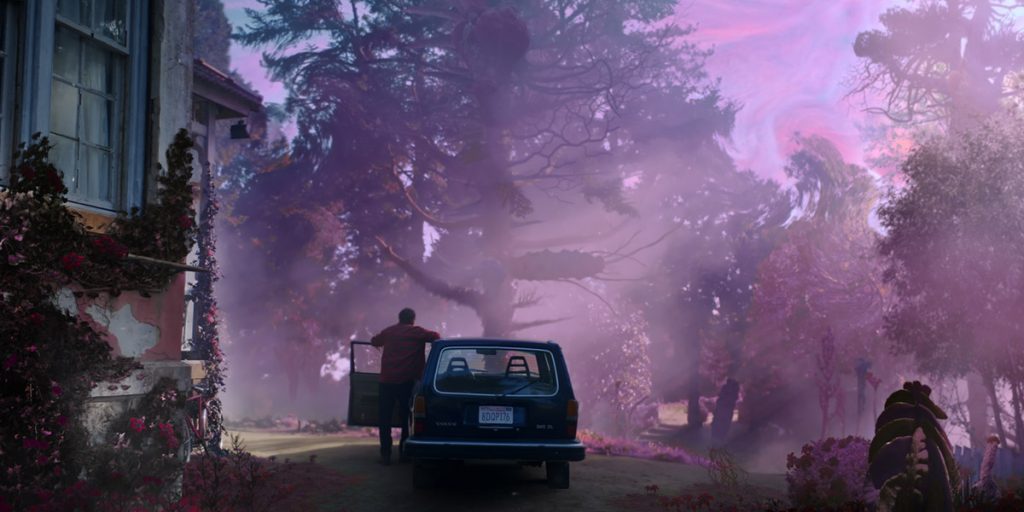January 23, 2020
by Carla Hay

Directed by Richard Stanley
Culture Representation: The movie’s characters are predominately white (with one African American, one Chinese Canadian and one Native American) who live in the fictional rural town of Arkham, Massachusetts.
Culture Clash: After a meteorite crashes on a family farm and strange things start to happen, the movie’s characters have conflicting degrees of skepticism and beliefs over what is logical science and what is the unexplainable supernatural.
Culture Audience: “Color Out of Space” will appeal the most to fans of campy B-movies in the sci-fi and horror genres.

Sometime in the 2010s, Oscar winner Nicolas Cage stopped being an A-list actor and started doing a steady stream of low-budget films (many of them released direct-to-video), where he usually plays a character who’s somewhere on the crazy spectrum. Cage has been very open in media interviews that his financial problems (wild spending, lawsuits over non-payment and IRS liens) have forced him to sell off many of his prized possessions. Apparently, this downsizing also extends to the budget and quality of movie jobs he’s been taking.
But somewhere along the way, Cage decided to have fun with these C-list movies by going into high-gear campiness in these roles. (His 2018 revenge flick “Mandy” already has a cult following.) Even though Cage tends to make films in the genres of action, drama and horror, make no mistake: His gleefully unhinged performances are now bringing a lot of comedy to his films.
In “Color Out of Space” (which is based on H.P. Lovecraft’s short story “The Colour Out of Space), Cage plays Nathan Gardner, the patriarch of a five-person clan living on a farm in the fictional rural town of Arkham, Massachusetts. The family, who used to live in a big city, includes Nathan’s wife Theresa (played by Joely Richardson), a recent survivor of breast cancer; teenage daughter Liviana (played by Madeleine Arthur), who fancies herself to be a Wiccan-inspired witch; teenage son Benny (played by Brendan Meyer), a rebellious stoner; and pre-teen son Jack (played by Julian Hillard), a near-perfect child who gets along with everyone.
In the film’s opening scene in a secluded wooden area, Liviana is wearing an outfit that looks like she’s on the way to a Renaissance Faire (cape and all), as she calls out to the spirits of earth, air, water, fire and ether to help heal her mother from cancer. She’s even got a white horse, which might be part of her attempt to look like some kind of fairy mystical princess. This is director Richard Stanley’s not-so-subtle way of telling the audience that Liviana represents someone who believes in the supernatural.
While she’s in this secluded spot, in walks Ward Phillips (played by Elliot Knight), who introduces himself as a hydrologist who’s surveying the water in the area. Ward seems to be kind of amused by Liviana’s outfit and her spiritual ritual, and he makes it clear that he’s a scientist who doesn’t believe in any of that witchy mumbo jumbo. Okay, we get it. Ward and Liviana are opposites.
Back at the farm, Liviana and Benny engage in some verbal sparring and name-calling (something they do several times in the movie) before the family settles in for the night. Their night is massively interrupted when a magenta glow takes over the atmosphere, and there’s a loud boom that feels like an explosion. Running outside, the family sees that a magenta meteorite surrounded by smoke has crashed into the front yard.
Ward and local law enforcement Sheriff Pierce (played by Josh C. Waller), who’s apparently the only cop on duty in this remote area, investigate the meteorite and don’t know what to make of it. Ward, who touches the meteor with his bare hands (not a very safe or scientific thing to do), advises the Gardners not to drink the water from their well until they can figure out what’s going on. Near the meteorite, there’s also a horrible odor that Nathan describes as smelling like a dog has been lit on fire.
Speaking of animals, Nathan is very proud to own several alpacas on the farm. He mentions the alpacas so much in the movie that it’s almost as if the screenwriters (director Stanley and Scarlett Amaris) deliberately made all these references to alpacas so people could make a drinking game out of it. It isn’t long before everyone on the farm (yes, including the alpacas) start to act strangely.
When the meteor first hit, Jack was temporarily in a catatonic state, but then he snapped out of it. Theresa also has a trance-like blackout while she’s cutting carrots in the kitchen. And let’s just say that the carrots aren’t the only things that get sliced. Then just as suddenly as the meteorite appeared, it disappeared from the yard. But the strange occurrences continue, such as weird voices amid static on the phone. And then Jack suddenly acts like he can hear voices that no one else can hear.
And what is famous stoner comedian Tommy Chong doing in this movie? Playing a hippie stoner named Ezra, a recluse who claims that he can find out what’s going on with all of these unexplained and frightening incidents. Ward spends some time at Ezra’s place to hear out his wild theories, but the mystery continues.
There are some glaring plot holes in this movie that are bigger than the crater left by the meteorite. Ward doesn’t do what a real scientist would do—contact his scientist colleagues to get their opinions. He’s the only science-based investigator in the entire movie. And even though the strange sightings make the local TV news (where a reporter openly mocks Nathan in an interview and makes Nathan look like a UFO-sighting nutjob), the publicity doesn’t bring out any curiosity seekers (including scientists) to the farm to take a look for themselves. But hey, this is a low-budget movie with a small cast. Don’t judge too harshly, because this movie doesn’t take itself too seriously.
It becomes apparent that the meteorite brought some non-human, unexpected and unwanted visitors to the area. And things get worse, as some members of the Gardner family develop a gruesome skin condition that leaves them writhing in pain. And one member of the family might or might not descend into madness. (Take a wild guess who it is. )
All of the actors in the film except for Cage are playing it straight in this deliberately bizarre horror flick. Cage’s wild, over-the-top mannerisms invite people to laugh along at the silliness of it all. (There were plenty of laughs at the screening that I attended, and they were all because of how Cage was acting on screen.) The visual effects are standard for this type of low-budget film, except for the last 15 minutes when there is some truly stunning imagery that’s more than a nod to psychedelia.
Crazy Cage, Crazy Chong and crazy, bloody chaos. What more could you want in a horror film? Oh, that’s right. Don’t forget the alpacas.
RLJE Films will release “Color Out of Space” in select U.S. cinemas and on VOD on January 24, 2020.
